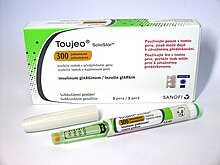
Back إنسولين غلارجين Arabic Inswlin Glargin CY Insulin glargin German Insulina glargina Spanish انسولین گلارژین FA Glargiini-insuliini Finnish Insuline glargine French Insulin glargin ID Insulina glargine Italian インスリン グラルギン Japanese
 Toujeo branded insulin glargine | |
| Clinical data | |
|---|---|
| Trade names | Lantus, others |
| Biosimilars | insulin glargine-aglr, insulin glargine-yfgn, Abasaglar, Rezvoglar, Semglee |
| AHFS/Drugs.com | Monograph |
| MedlinePlus | a600027 |
| License data | |
| Pregnancy category |
|
| Routes of administration | Subcutaneous |
| ATC code | |
| Legal status | |
| Legal status | |
| Pharmacokinetic data | |
| Onset of action | ~1 hour[7] |
| Duration of action | 24–36 hours[7] |
| Identifiers | |
| |
| CAS Number | |
| IUPHAR/BPS | |
| DrugBank | |
| ChemSpider |
|
| UNII | |
| KEGG | |
| CompTox Dashboard (EPA) | |
| ECHA InfoCard | 100.241.126 |
| Chemical and physical data | |
| Formula | C267H404N72O78S6 |
| Molar mass | 6062.96 g·mol−1 |
| | |
Insulin glargine sold under the brand name Lantus among others is a long-acting modified form of medical insulin, used in the management of type 1 and type 2 diabetes.[7] It is injected just under the skin.[7] Effects generally begin an hour after use.[7]
Common side effects include low blood sugar, problems at the site of injection, itchiness, and weight gain.[7] Other serious side effects include low blood potassium.[7] NPH insulin rather than insulin glargine is generally preferred in pregnancy.[8] After injection, microcrystals slowly release insulin for about 24 hours.[7] This insulin causes body tissues to absorb glucose from the blood and decreases glucose production by the liver.[7]
Insulin glargine was patented, but the patent expired in most jurisdictions in 2014. It was approved for medical use in the United States in 2000.[7] It is on the World Health Organization's List of Essential Medicines.[9] In 2022, it was the 28th most commonly prescribed medication in the United States, with more than 18 million prescriptions.[10][11] In July 2021, the US Food and Drug Administration (FDA) approved an interchangeable biosimilar insulin product called Semglee (insulin glargine-yfgn) for the treatment of diabetes.[12]
- ^ "Insulin glargine Use During Pregnancy". Drugs.com. 6 April 2020. Archived from the original on 21 October 2020. Retrieved 4 September 2020.
- ^ "Summary Basis of Decision - Semglee". Health Canada. 23 August 2022. Archived from the original on 29 September 2022. Retrieved 29 September 2022.
- ^ "Lantus 100 units/ml solution for injection in a cartridge - Summary of Product Characteristics (SmPC)". (emc). Archived from the original on 9 January 2021. Retrieved 7 May 2020.
- ^ "Lantus- insulin glargine injection, solution Lantus SoloStar- insulin glargine injection, solution". DailyMed. Archived from the original on 29 July 2021. Retrieved 29 July 2021.
- ^ "Lantus EPAR". European Medicines Agency (EMA). 8 May 2009. Archived from the original on 4 August 2020. Retrieved 28 July 2021.
- ^ "Toujeo EPAR". European Medicines Agency (EMA). 11 May 2009. Archived from the original on 29 July 2021. Retrieved 28 July 2021.
- ^ a b c d e f g h i j "Insulin Glargine Monograph for Professionals". Drugs.com. AHFS. Archived from the original on 5 December 2020. Retrieved 23 December 2018.
- ^ British national formulary: BNF 76 (76th ed.). Pharmaceutical Press. 2018. p. 701. ISBN 9780857113382.
- ^ World Health Organization (2023). The selection and use of essential medicines 2023: web annex A: World Health Organization model list of essential medicines: 23rd list (2023). Geneva: World Health Organization. hdl:10665/371090. WHO/MHP/HPS/EML/2023.02.
- ^ "The Top 300 of 2022". ClinCalc. Archived from the original on 30 August 2024. Retrieved 30 August 2024.
- ^ "Insulin Glargine Drug Usage Statistics, United States, 2013 - 2022". ClinCalc. Retrieved 30 August 2024.
- ^ Cite error: The named reference
FDA PR 20210728was invoked but never defined (see the help page).